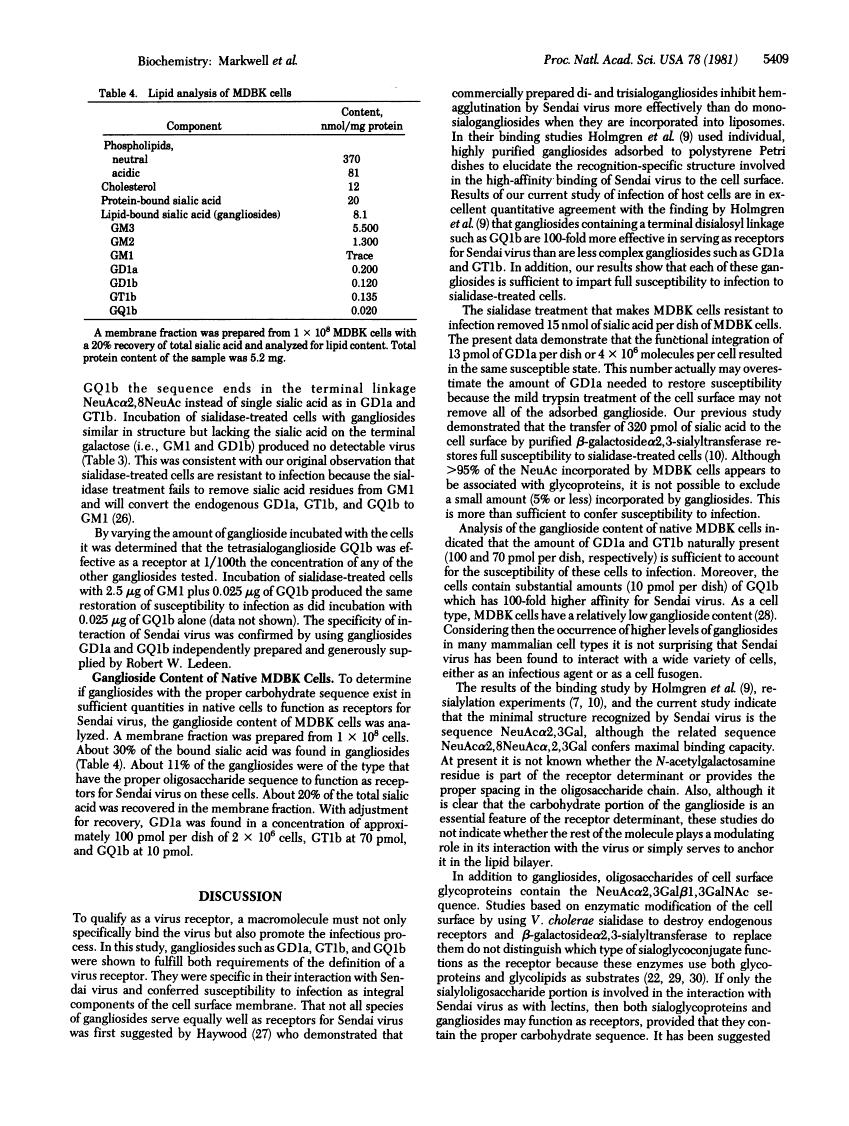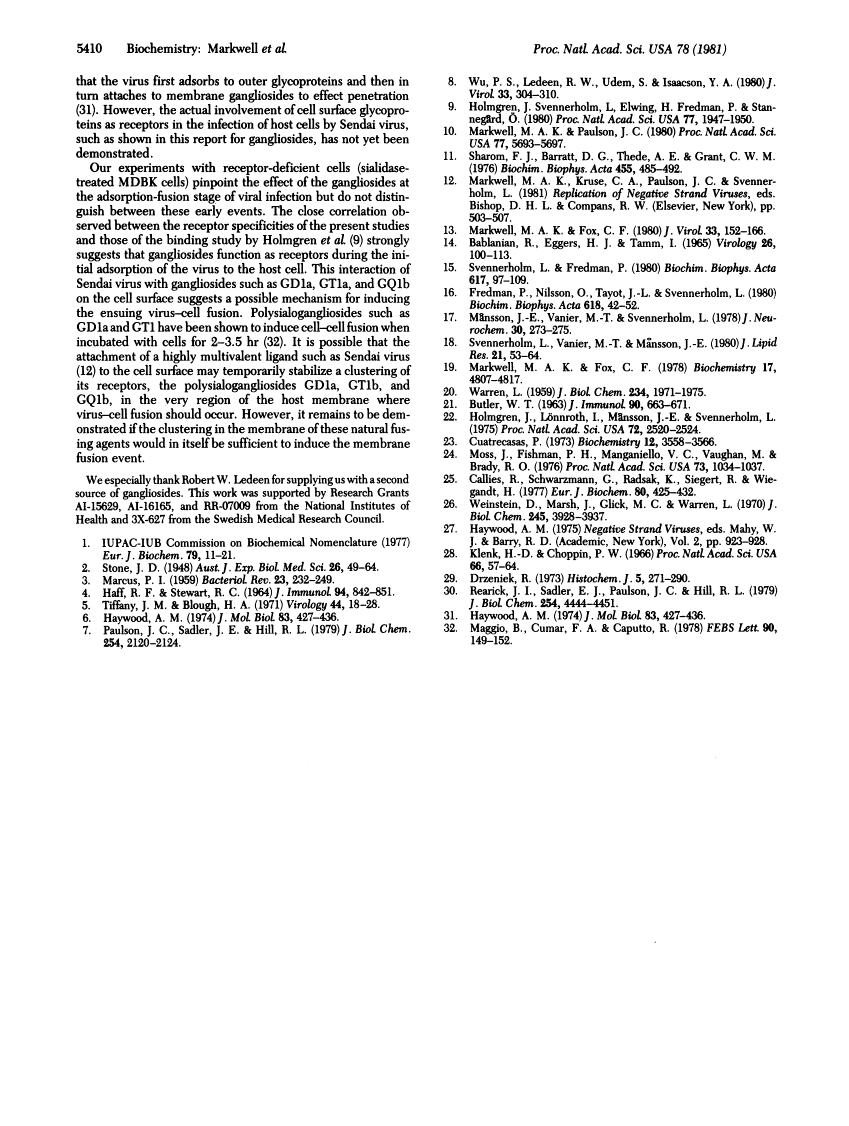Abstract
Free full text

Specific gangliosides function as host cell receptors for Sendai virus.
Abstract
The ability of specific gangliosides to function as host cell receptors for Sendai virus was investigated by using Madin-Darby bovine kidney cells which become resistant to infection upon treatment with Vibrio cholerae sialidase. Sialidase-treated cells were incubated for 20 min at 37 degrees C with individual, highly purified gangliosides containing homogeneous carbohydrate moieties and then inoculated with virus for 10 min. Susceptibility of the cells to infection was monitored by hemagglutination titer of the virus produced 48 hr after inoculation. Incubation of the cells with gangliosides containing the sequence NeuAc alpha 2,3Gal beta 1,3GalNAc (i.e., GD1a, GT1b, and GQ1b) fully restored susceptibility to infection to the cells. However, the ganglioside GQ1b in which the sequence ends with two sialic acids in a NeuAc alpha 2,8NeuAc linkage instead of a single sialic acid as in GD1a and GT1b, was effective as a receptor at a concentration 1/100th that of any of the other gangliosides tested. Incubation with gangliosides similar in structure to GD1a, GT1b, and GQ1b but lacking the sialic acid attached to the terminal galactose (i.e., GM1 and GD1b) had no effect. The results from control experiments in which gangliosides were incubated at 0 degrees C with cells or in which trypsin was used to remove gangliosides adsorbed to cells were consistent with the premise that the gangliosides must actually insert into the cellular membrane to function as Sendai virus receptors. Addition of 4 X 10(6) molecules of 14C-labeled GD1a per cell made the cells fully susceptible to infection. Analysis of the ganglioside content of cell membranes showed that gangliosides GD1a, GT1b, and GQ1b are natural components of these cells and are present in quantities sufficient to act as receptors. These results demonstrate that gangliosides with the proper carbohydrate sequence, such as GD1a, GT1b, and GQ1b, function as natural receptors for Sendai virus in host cells.
Full text
Full text is available as a scanned copy of the original print version. Get a printable copy (PDF file) of the complete article (1.1M), or click on a page image below to browse page by page. Links to PubMed are also available for Selected References.
Selected References
These references are in PubMed. This may not be the complete list of references from this article.
- MARCUS PI. Symposium on the biology of cells modified by viruses or antigens. IV. Single-cell techniques in tracing virus-host interactions. Bacteriol Rev. 1959 Dec;23(4):232–249. [Europe PMC free article] [Abstract] [Google Scholar]
- HAFF RF, STEWART RC. ROLE OF SIALIC ACID RECEPTORS IN ADSORPTION OF INFLUENZA VIRUS TO CHICK EMBRYO CELLS. J Immunol. 1965 Jun;94:842–851. [Abstract] [Google Scholar]
- Tiffany JM, Blough HA. Attachment of myxoviruses to artificial membranes: electron microscopic studies. Virology. 1971 Apr;44(1):18–28. [Abstract] [Google Scholar]
- Haywood AM. Characteristics of Sendai virus receptors in a model membrane. J Mol Biol. 1974 Mar 15;83(4):427–436. [Abstract] [Google Scholar]
- Paulson JC, Sadler JE, Hill RL. Restoration of specific myxovirus receptors to asialoerythrocytes by incorporation of sialic acid with pure sialyltransferases. J Biol Chem. 1979 Mar 25;254(6):2120–2124. [Abstract] [Google Scholar]
- Wu PS, Ledeen RW, Udem S, Isaacson YA. Nature of the Sendai virus receptor: glycoprotein versus ganglioside. J Virol. 1980 Jan;33(1):304–310. [Europe PMC free article] [Abstract] [Google Scholar]
- Holmgren J, Svennerholm L, Elwing H, Fredman P, Strannegård O. Sendai virus receptor: proposed recognition structure based on binding to plastic-adsorbed gangliosides. Proc Natl Acad Sci U S A. 1980 Apr;77(4):1947–1950. [Europe PMC free article] [Abstract] [Google Scholar]
- Markwell MA, Paulson JC. Sendai virus utilizes specific sialyloligosaccharides as host cell receptor determinants. Proc Natl Acad Sci U S A. 1980 Oct;77(10):5693–5697. [Europe PMC free article] [Abstract] [Google Scholar]
- Sharom FJ, Barratt DG, Thede AE, Grant CW. Glycolipids in model membranes. Spin label and freeze-etch studies. Biochim Biophys Acta. 1976 Dec 2;455(2):485–492. [Abstract] [Google Scholar]
- Markwell MA, Fox CF. Protein-protein interactions within paramyxoviruses identified by native disulfide bonding or reversible chemical cross-linking. J Virol. 1980 Jan;33(1):152–166. [Europe PMC free article] [Abstract] [Google Scholar]
- BABLANIAN R, EGGERS HJ, TAMM I. STUDIES ON THE MECHANISM OF POLIOVIRUS-INDUCED CELL DAMAGE. I. THE RELATION BETWEEN POLIOVIRUS,-INDUCED METABOLIC AND MORPHOLOGICAL ALTERATIONS IN CULTURED CELLS. Virology. 1965 May;26:100–113. [Abstract] [Google Scholar]
- Svennerholm L, Fredman P. A procedure for the quantitative isolation of brain gangliosides. Biochim Biophys Acta. 1980 Jan 18;617(1):97–109. [Abstract] [Google Scholar]
- Fredman P, Nilsson O, Tayot JL, Svennerholm L. Separation of gangliosides on a new type of anion-exchange resin. Biochim Biophys Acta. 1980 Apr 18;618(1):42–52. [Abstract] [Google Scholar]
- Mansson JE, Vanier MT, Svennerholm L. Changes in the fatty acid and sphingosine composition of the major gangliosides of human brain with age. J Neurochem. 1978 Jan;30(1):273–275. [Abstract] [Google Scholar]
- Svennerholm L, Vanier MT, Månsson JE. Krabbe disease: a galactosylsphingosine (psychosine) lipidosis. J Lipid Res. 1980 Jan;21(1):53–64. [Abstract] [Google Scholar]
- Markwell MA, Fox CF. Surface-specific iodination of membrane proteins of viruses and eucaryotic cells using 1,3,4,6-tetrachloro-3alpha,6alpha-diphenylglycoluril. Biochemistry. 1978 Oct 31;17(22):4807–4817. [Abstract] [Google Scholar]
- WARREN L. The thiobarbituric acid assay of sialic acids. J Biol Chem. 1959 Aug;234(8):1971–1975. [Abstract] [Google Scholar]
- BUTLER WT. HEMAGGLUTINATION STUDIES WITH FORMALINIZED ERYTHROCYTES. EFFECT OF BIS-DIAZO-BENZIDINE AND TANNIC ACID TREATMENT ON SENSITIZATION BY SOLUBLE ANTIGEN. J Immunol. 1963 May;90:663–671. [Abstract] [Google Scholar]
- Holmgren J, Lönnroth I, Månsson J, Svennerholm L. Interaction of cholera toxin and membrane GM1 ganglioside of small intestine. Proc Natl Acad Sci U S A. 1975 Jul;72(7):2520–2524. [Europe PMC free article] [Abstract] [Google Scholar]
- Cuatrecasas P. Gangliosides and membrane receptors for cholera toxin. Biochemistry. 1973 Aug 28;12(18):3558–3566. [Abstract] [Google Scholar]
- Moss J, Fishman PH, Manganiello VC, Vaughan M, Brady RO. Functional incorporation of ganglioside into intact cells: induction of choleragen responsiveness. Proc Natl Acad Sci U S A. 1976 Apr;73(4):1034–1037. [Europe PMC free article] [Abstract] [Google Scholar]
- Callies R, Schwarzmann G, Radsak K, Siegert R, Wiegandt H. Characterization of the cellular binding of exogenous gangliosides. Eur J Biochem. 1977 Nov 1;80(2):425–432. [Abstract] [Google Scholar]
- Weinstein DB, Marsh JB, Glick MC, Warren L. Membranes of animal cells. VI. The glycolipids of the L cell and its surface membrane. J Biol Chem. 1970 Aug 10;245(15):3928–3937. [Abstract] [Google Scholar]
- Klenk HD, Choppin PW. Glycosphingolipids of plasma membranes of cultured cells and an enveloped virus (SV5) grown in these cells. Proc Natl Acad Sci U S A. 1970 May;66(1):57–64. [Europe PMC free article] [Abstract] [Google Scholar]
- Drzeniek R. Substrate specificity of neuraminidases. Histochem J. 1973 May;5(3):271–290. [Abstract] [Google Scholar]
- Rearick JI, Sadler JE, Paulson JC, Hill RL. Enzymatic characterization of beta D-galactoside alpha2 leads to 3 sialyltransferase from porcine submaxillary gland. J Biol Chem. 1979 Jun 10;254(11):4444–4451. [Abstract] [Google Scholar]
- Haywood AM. Characteristics of Sendai virus receptors in a model membrane. J Mol Biol. 1974 Mar 15;83(4):427–436. [Abstract] [Google Scholar]
- Maggio B, Cumar FA, Caputto R. Induction of membrane fusion by polysialogangliosides. FEBS Lett. 1978 Jun 1;90(1):149–152. [Abstract] [Google Scholar]
Associated Data
Articles from Proceedings of the National Academy of Sciences of the United States of America are provided here courtesy of National Academy of Sciences
Full text links
Read article at publisher's site: https://doi.org/10.1073/pnas.78.9.5406
Read article for free, from open access legal sources, via Unpaywall:
https://europepmc.org/articles/pmc348754?pdf=render
Citations & impact
Impact metrics
Article citations
Sendai virus-mediated RNA delivery restores fertility to congenital and chemotherapy-induced infertile female mice.
PNAS Nexus, 3(9):pgae375, 03 Sep 2024
Cited by: 0 articles | PMID: 39262851 | PMCID: PMC11388103
Respiratory viruses interacting with cells: the importance of electrostatics.
Front Microbiol, 14:1169547, 27 Jun 2023
Cited by: 2 articles | PMID: 37440888 | PMCID: PMC10333706
Review Free full text in Europe PMC
Electrostatic Surface Potential as a Key Parameter in Virus Transmission and Evolution: How to Manage Future Virus Pandemics in the Post-COVID-19 Era.
Viruses, 15(2):284, 19 Jan 2023
Cited by: 8 articles | PMID: 36851498 | PMCID: PMC9964723
Review Free full text in Europe PMC
The ganglioside GM1a functions as a coreceptor/attachment factor for dengue virus during infection.
J Biol Chem, 298(11):102570, 07 Oct 2022
Cited by: 2 articles | PMID: 36209827 | PMCID: PMC9650044
Sialic acid: an attractive biomarker with promising biomedical applications.
Asian Biomed (Res Rev News), 16(4):153-167, 31 Aug 2022
Cited by: 3 articles | PMID: 37551166 | PMCID: PMC10321195
Review Free full text in Europe PMC
Go to all (113) article citations
Similar Articles
To arrive at the top five similar articles we use a word-weighted algorithm to compare words from the Title and Abstract of each citation.
Expression of gangliosides as receptors at the cell surface controls infection of NCTC 2071 cells by Sendai virus.
Virology, 155(2):356-364, 01 Dec 1986
Cited by: 15 articles | PMID: 3024393
Sendai virus receptor: proposed recognition structure based on binding to plastic-adsorbed gangliosides.
Proc Natl Acad Sci U S A, 77(4):1947-1950, 01 Apr 1980
Cited by: 42 articles | PMID: 6246515 | PMCID: PMC348626
Receptor ganglioside content of three hosts for Sendai virus. MDBK, HeLa, and MDCK cells.
Biochim Biophys Acta, 775(1):7-16, 01 Aug 1984
Cited by: 29 articles | PMID: 6087902
Role of sialic acid-containing molecules in paramyxovirus entry into the host cell: a minireview.
Glycoconj J, 23(1-2):5-17, 01 Feb 2006
Cited by: 86 articles | PMID: 16575518
Review
Funding
Funders who supported this work.
NCRR NIH HHS (1)
Grant ID: RR-07009
NIAID NIH HHS (2)
Grant ID: AI-16165
Grant ID: AI-15629










